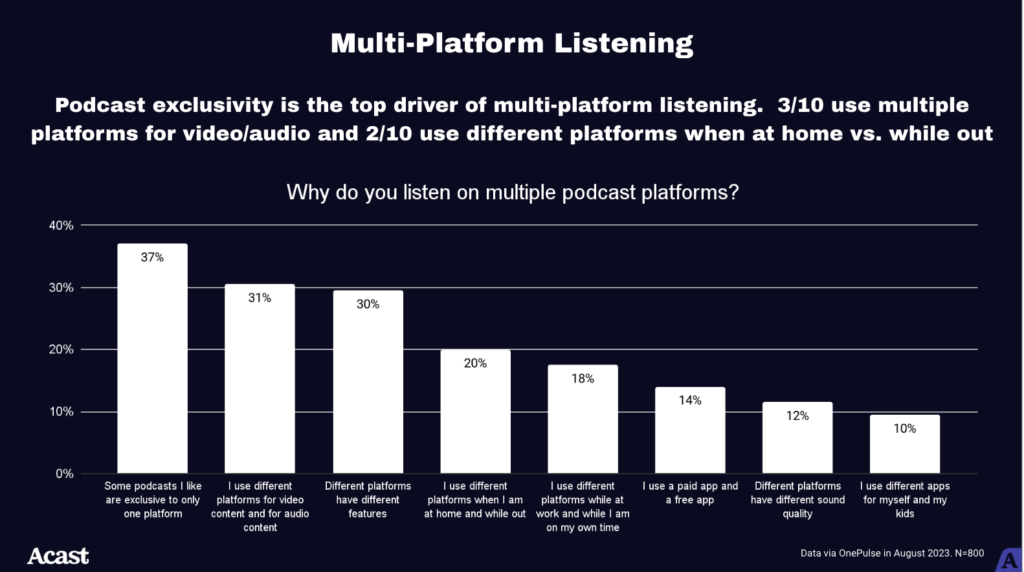Today in the Business of Podcasting
Over 100 new podcasts from top apps and services launch on Apple Podcasts
This afternoon Apple has announced some new Apple Podcasts additions with iOS 17. Subscribers to apps such as Apple Music, Apple News+, Calm, and LingoKids now have access to over 60 original podcasts, with more shows from top apps and services launching weekly throughout this fall. Listeners with in-app subscriptions to eligible apps will be automatically connected to the publication’s channel and see every podcast they have access to in their Library tab. In addition to a slate of podcasts from publications like Bloomberg and the Washington Post, Apple has launched a daily news briefing titled Apple News Today, a weekly interview show Apple News In Conversation, and Apple News+ Narrated, a catalog of audio stories produced by News+ publishers. [Source]
Hispanics Remain Big Audio Users, But Nielsen Says Language Is Less A Factor Than In The Past.
Nielsen’s RADAR report for March finds 94% of Hispanic respondents aged 18-49 listen to AM/FM radio on at least a monthly basis. The report also found Hispanic listeners are 13% more likely to consume podcasts when compared to the general population. With a growing percentage of second and third generation Hispanic people in the population, simply providing general content translated in Spanish isn’t enough. So when considering content for this Hispanic Heritage Month, and any content going forward, keep in mind the necessary balance between an audience’s language preference and making that content relevant to the intended audience. [Source]
Tell Me a Story: What Podcast Format Works Best for Brands? By Annalise Nielsen.
New data from Signal Hill Insights and Pacific Content demonstrates that while a branded chat or interview podcast might be attractive, there’s another option. When tested for brand favorability, branded podcasts that took a narrative approach saw an average lift ten percentage points higher than those using a conversation or interview format. Pacific Content’s Head of Strategy and Development, Annalise Nielsen, suggests this gulf of difference is likely due in some part to narrative podcasts having higher quality control built in. Content is more likely to be massaged, edited, or cut when everything is edited, versus a conversational branded podcasts, which might favor raw content over intensive editing. The key to good branded content, according to Nielsen, is remembering to ask the question “what is the listener getting out of this?” [Source]
Household spending on streaming is going down by Kelsey Sutton
According to findings from research firm Parks Associates, who survey 10,000 U.S. internet households each quarter, streaming subscription spending in the U.S. has dropped 25% in two years. The average has now dropped to $73 per month. At the same time, free ad-supported streaming services continue their four-year streak of increasing market share, with at least a third of surveyed households consuming one of the services by the end of 2022. More than 40% of users on ad-supported streamers say there are “far too many ads.” Podcasting finds itself in an advantageous position, as generally paid podcast subscriptions eliminate ads, and podcasts generally have lower ad frequency than connected TV ad pods. [Source]
As for the rest of the news… we’ve got a double serving of Spotify for you today. First: AdWeek covers how a Spotify campaign in Mexico is leveraging Gen Z’s sudden love of corridos, and Spotify has a few more details about their AI voice translation pilot program.
Data Snapshot
What it says: There are a variety of reasons why people listen to podcasts on multiple platforms, ranging from using different platforms for video/audio to people using different platforms at work vs. while at home.
What it means: Multi-platform listening is complex and has many causes, meaning that it is here to stay.
Why it’s not cool: Podcast exclusivity is the top driver why people listen on multiple platforms – the more podcasts that use a traditional RSS feed and are accessible on any podcatchers, the less consumers will be pushed to jump between apps









































































































































































































